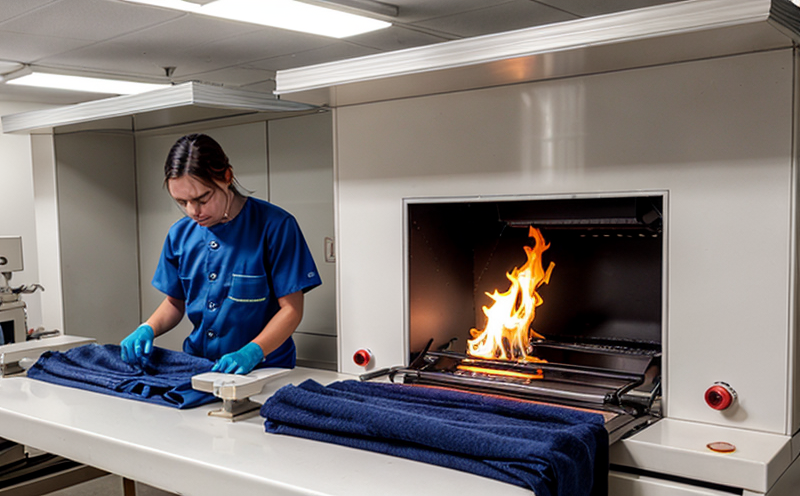Flammability Testing of Casual Wear
The flammability testing of casual wear is a critical aspect of ensuring product safety and compliance with international standards. This service plays a crucial role in safeguarding consumers from potential hazards, especially when the apparel comes into contact with heat sources such as flames or sparks. Flammability tests are designed to evaluate how a fabric behaves under fire exposure conditions, thereby assessing its resistance to ignition and self-extinguishing properties.
Flame-resistant textiles are essential for clothing items that might be exposed to open flames during normal wear and use, such as jackets, pants, and shirts. The testing process typically involves exposing the material to a controlled flame source for a specified duration while monitoring various parameters like burn time, after-flame duration, and smoldering behavior. These tests are conducted using standardized procedures defined by organizations such as ASTM International (ASTM D6413), ISO 13565-1, and EN 13917.
It is important to note that flammability testing focuses not only on the fabric itself but also considers how it interacts with other components like zippers, buttons, and linings. In some cases, entire garments may be tested rather than individual materials. This holistic approach ensures that the final product meets stringent safety requirements.
For quality managers and compliance officers responsible for ensuring product safety, flammability testing offers valuable insights into potential risks associated with specific fabrics or designs. By conducting these tests early in the development process, manufacturers can identify any issues before they become costly mistakes down the line. Additionally, R&D engineers benefit from this service by gaining deeper understanding of material performance characteristics under fire exposure conditions.
When it comes to selecting appropriate testing methods, several factors must be considered including fabric type (natural fibers vs synthetic blends), end use application, and target market region(s). For instance, certain regions have more stringent regulations regarding flame resistance than others. Compliance officers need to stay informed about local laws and directives to ensure their products meet all necessary requirements.
Proper specimen preparation is vital for accurate results during flammability testing. Specimens should represent typical cuts of the fabric or garment being tested, with consistent dimensions that reflect real-world conditions as closely as possible. In some instances, multiple specimens may need to be prepared depending on the test method selected.
The instrumentation used in flammability testing includes specialized equipment designed specifically for this purpose. Common devices include cone calorimeters, oxygen index testers, and vertical flame testers among others. Each device serves a unique function aimed at capturing specific aspects of material behavior under fire exposure conditions.
Once testing is complete, detailed reports are generated summarizing all key findings related to the flammability performance of the tested materials or garments. These reports serve as valuable tools for decision-making purposes within various stages of product development cycles—from initial concept through final production phases.
Applied Standards
Flammability testing of casual wear must adhere to strict guidelines outlined by recognized standards bodies like ASTM, ISO, and EN. Some commonly referenced standards include:
- ASTM D6413: Standard Test Method for Determination of Flame Resistance of Textile Fabrics
- ISO 13565-1: Specification and test methods for flame resistance of fabrics used in protective clothing
- EN 13917: Personal protective equipment—Protective clothing against fire hazards
These standards provide detailed instructions on sample preparation, testing procedures, data analysis techniques, and acceptable limits for various parameters measured during flammability tests. Adherence to these guidelines ensures consistency across different laboratories performing similar tests while also providing confidence that results are reliable and reproducible.
Benefits
- Enhanced Consumer Safety: By ensuring that casual wear meets flammability standards, manufacturers contribute significantly to protecting end users from accidental fire incidents.
- Regulatory Compliance: Adherence to applicable regulations helps avoid legal disputes and potential recalls due to non-compliance issues.
- Improved Product Reputation: Brands that prioritize safety through rigorous quality control measures tend to enjoy better brand loyalty among consumers who appreciate responsible manufacturing practices.
- Cost Efficiency: Early identification of problematic materials or designs reduces the likelihood of costly rework efforts later in the production cycle.
The benefits extend beyond just meeting regulatory requirements; they encompass broader goals related to business sustainability and social responsibility. Companies that invest in comprehensive flammability testing programs demonstrate their commitment to creating safer environments for everyone involved in the lifecycle of a product—from raw material suppliers to consumers.
Industry Applications
| Industry Segment | Typical Products | Flammability Requirements |
|---|---|---|
| Clothing & Apparel | Jackets, pants, shirts, coats | ASTM D6413, ISO 13565-1 |
| Furnishing Fabrics | Curtains, upholstery, bedding | EN 13917 |
| Personal Protective Equipment (PPE) | Gloves, helmets, respirators | ASTM F1506, EN 468-2 |
In addition to these sectors, flammability testing can be applied across various other industries where textiles are used in close proximity to potential fire hazards. The key takeaway is that any industry dealing with fabrics or materials that could potentially come into contact with flames should consider implementing robust flammability testing protocols.





